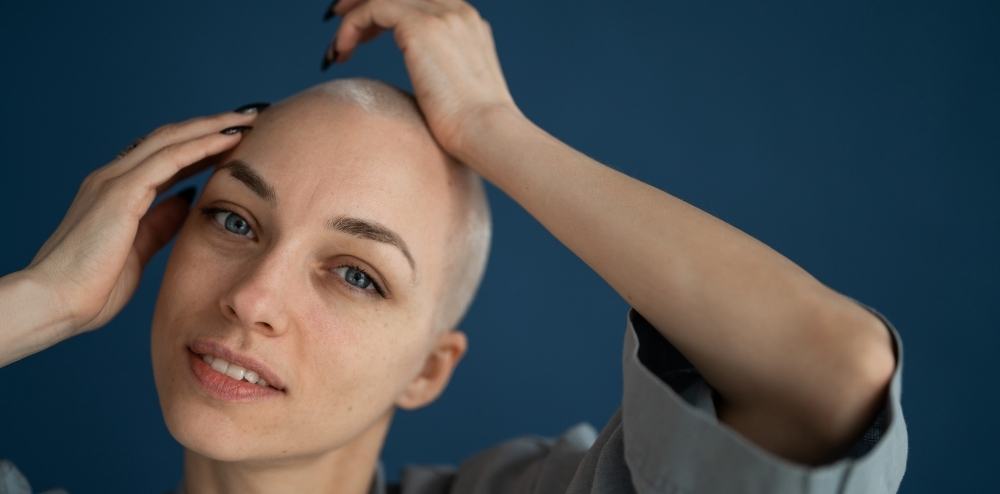Both men and women have concerns about hair loss. While male pattern baldness is well-known, female hair loss is not as commonly acknowledged. However, hair loss in women is a legitimate worry that can have serious emotional consequences. We will look at female hair loss, its causes, and treatment options in this blog post.
Is Hair Loss in Women Common?
Women’s hair loss is more prevalent than you might assume. While male pattern baldness affects almost half of all males by the age of 50, female hair loss affects approximately 30 million women in the United States alone. Women often encounter general hair thinning rather than bald spots when it comes to hair loss. Female hair loss, on the other hand, can have a substantial impact on a woman’s self-esteem and confidence.
What Causes Female Hair Loss?
Women may have hair loss for a variety of causes. Hormonal changes, such as those encountered during pregnancy, menopause, or when taking birth control pills, are one of the most common causes.
Among the most common causes are:
Androgenetic alopecia: often known as female pattern hair loss, is the most common cause of hair loss in women. It is caused by a genetic predisposition and hormonal changes, resulting in a distinct pattern of hair loss or balding.
Hormonal Imbalance: Hormonal changes caused by menopause, thyroid diseases, pregnancy, or birth control drugs might result in female hair loss.
Nutritional Deficiencies: Women’s hair thinning and loss can be caused by a lack of key nutrients such as iron, protein, and vitamins.
Stress: Chronic stress can cause hair loss in women by causing the hair to enter the telogen, or resting, phase.
Hairstyling Techniques: Excessive use of hairstyling equipment and chemical treatments can harm the hair shaft and result in hair loss.
Medical illnesses: Hair loss in women can be caused by medical illnesses such as alopecia areata, lupus, and scalp infections.
Medications: Certain medications used for treating hypertension, cholesterol, and cancer can cause hair loss as a side effect.
Age: As women age, their hair thins and their hair growth cycle slows, resulting in hair loss.
A skilled hair specialist should be consulted to diagnose the cause of hair loss and to provide appropriate treatment choices.
Female Hair Loss Types
Female hair loss can be classified into three types: female pattern hair loss (FPHL), telogen effluvium, and alopecia areata. The most frequent kind is FPHL, which is characterized by thinning hair in the crown and along the portion. Telogen effluvium occurs when the regular hair growth cycle is disrupted, resulting in excessive shedding. Alopecia areata is an autoimmune disorder characterized by patchy hair loss.
Signs of Hair Loss in Women
Women’s hair loss symptoms can seem insignificant, such as a wider part, a smaller ponytail, or more hair left in your brush or shower drain than usual. If you are concerned about hair loss, it is critical that you pay attention to these indicators and get medical help.
Is it possible to prevent female hair loss?
While some causes of female hair loss, such as genetics, cannot be avoided, women can take action to prevent hair loss like, eating a nutritious diet, avoiding hairstyles that tug on the hair, lowering stress, and utilizing gentle hair care products.
Female Hair Loss Treatment Options
Depending on the origin and severity of the issue, there are numerous therapy options for female hair loss. Among these alternatives are:
Topical treatments: such as minoxidil, are frequently used to treat female pattern hair loss. Minoxidil is a topical solution that is administered to the scalp to encourage hair growth.
Hair Transplant: A hair transplant is a surgical treatment that involves extracting hair follicles from the donor area and transplanting them into balding or thinning areas of the scalp. It is a long-term remedy for female hair loss.
Low-level laser therapy (LLLT): LLLT is a non-invasive treatment that uses low-level laser devices to increase hair growth and thicken hair.
Scalp Micropigmentation: is a non-surgical process that includes tattooing the scalp to provide the impression of a full head of hair. It is a popular alternative for ladies who have experienced significant hair loss.
To discover the best treatment choice for you, speak with a certified hair transplant surgeon or dermatologist.
The Importance of Self-Care
Dealing with hair loss may be a stressful process, and women must take care of themselves both physically and mentally. This can involve getting enough rest, exercising regularly, engaging in stress-relieving activities like yoga or meditation, and seeking help from family, friends, or a therapist if necessary.
Hair Transplant Clinics’ Role in Female Hair Loss Treatment
Hair transplant clinics can be quite beneficial to women suffering from hair loss. These clinics can help women restore their confidence and improve their quality of life by providing complete exams, reliable diagnoses, and a variety of treatment options including hair transplant operations.
Conclusion
To summarize, hair loss is a widespread issue among women and can have a substantial influence on their self-esteem and quality of life. While women do not experience baldness as males do, they can experience hair thinning and loss for a variety of causes. Women, fortunately, have various hair restoration alternatives to help them restore their hair and confidence. A skilled hair specialist should be consulted to diagnose the cause of hair loss and to provide a proper treatment plan.







